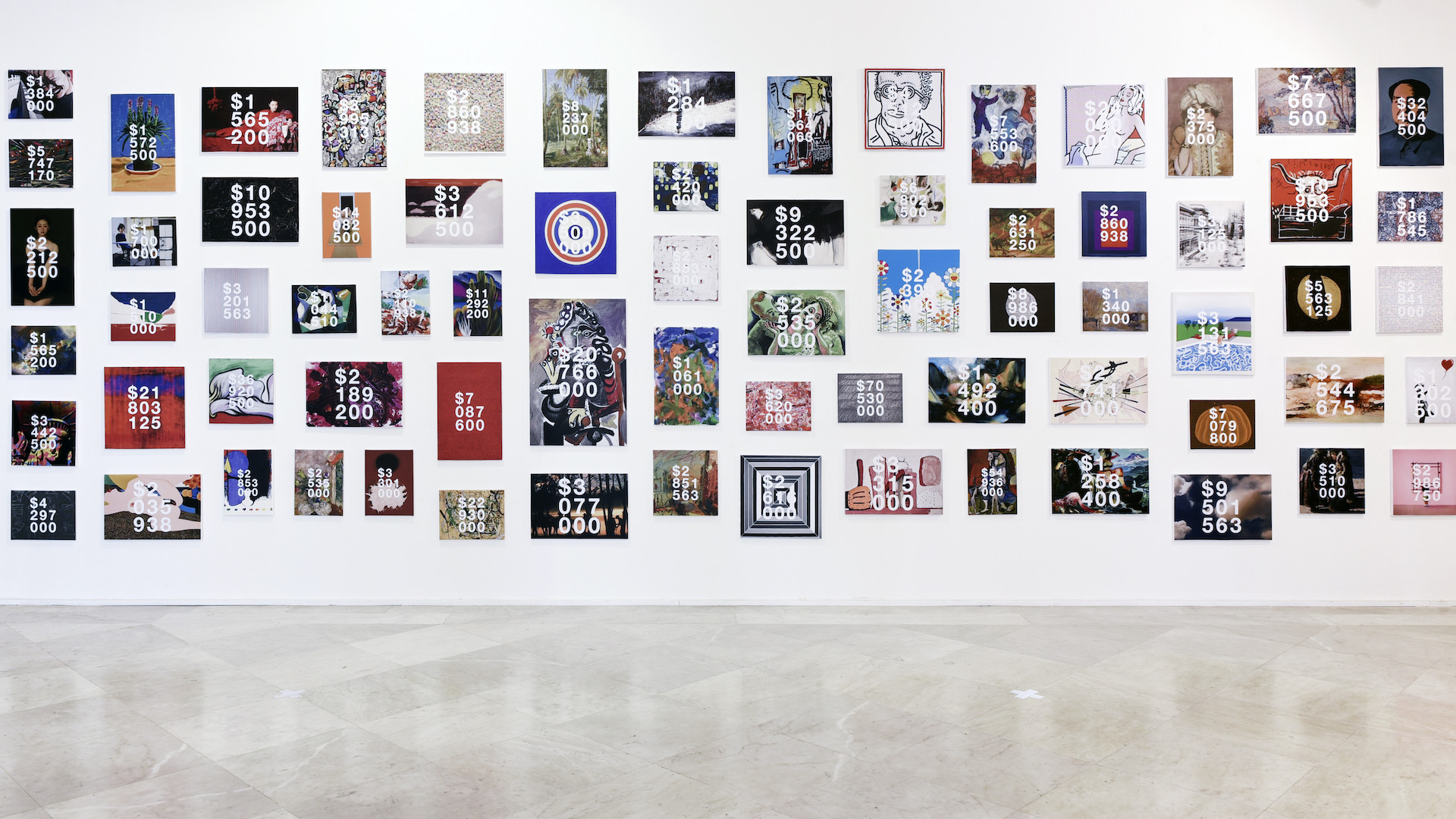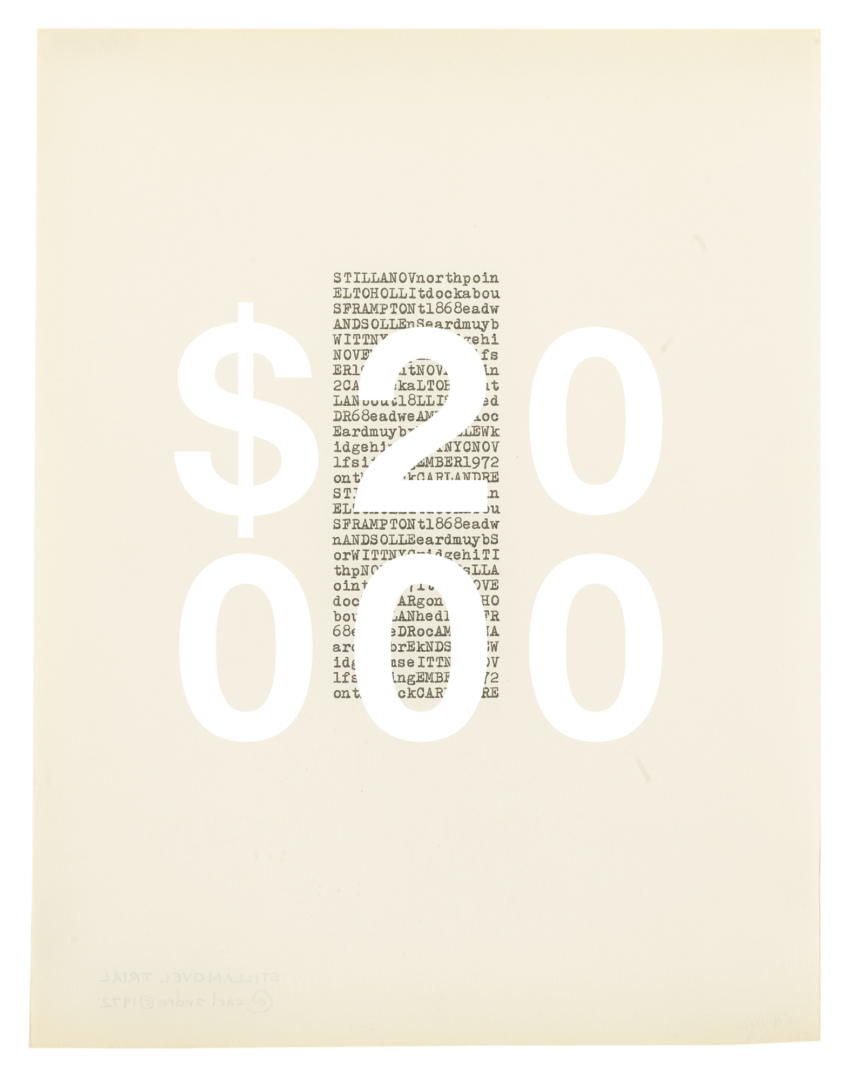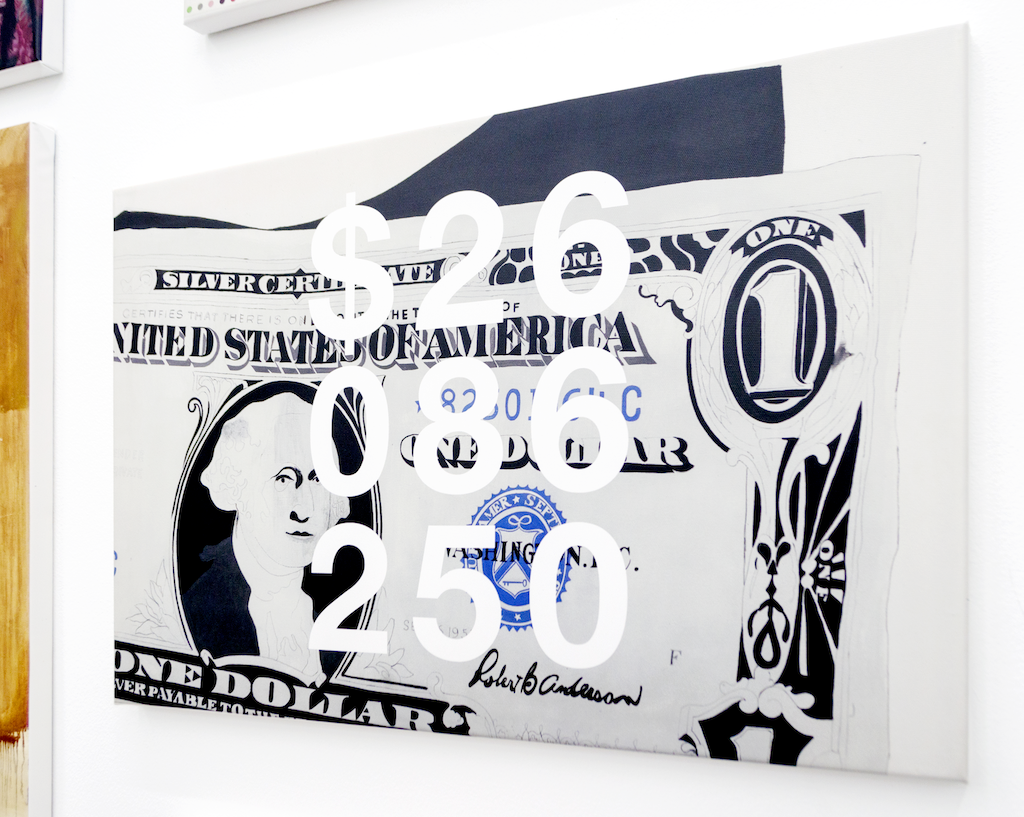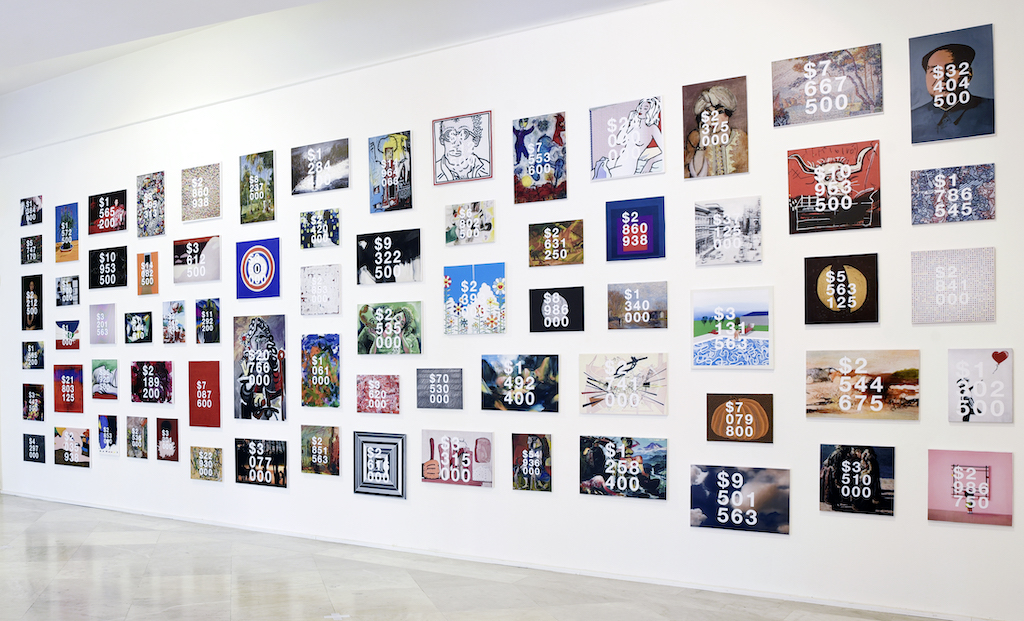Paolo Cirio

I recently acquired a work of art that is also a financial product. So far, nothing that is likely to disturb this sad pleonasm, however, the reverse is also true, and even more so: this financial-product-which-is-also-a-work-of-art is in fact both a financial product squared and a work of art squared. And since I really like squares, I chose a Carl Andre. I must say that the choice was vast: more than 100,000 works in the catalog, and at unbeatable prices. For my part, I can say that I invested $0.2 (which is less than the $0.32 administration fee to be added). But what did I actually buy? Well, I bought a derivative. In other words, a product whose valuation derives from that of an asset that is described as underlying. And concretely? A digital file accompanied by a document that serves as a certificate of authenticity, a sales contract, and, therefore, a derivative contract. And even more precisely? The certified unique image of a poem by Carl Andre taken from the Sotheby’s auction catalog, partially covered with large white figures: its auction price of nearly two years ago, $20,000. So, for 0.00001% of the value of the original work, I bought a work ‘derived’ from it whose value may increase 10 times if the value of the original work decreases (i.e. if it is sold below its estimated price, is bought internally by the auction house or remains unsold over a given period of time), thus ironically bypassing the auction house. The author of this ‘squared’ work is Paolo Cirio, accustomed to interventionist practices in the systems that govern us (economic, legal, technological, media, political…) and advocate of what he calls “Regulatory Art”, an art that would mitigate, in his words, “the consequences of deregulation which is driven by speculative finance, technolibertarianism, mass surveillance, civil rights suppression and environmental destruction” without forgetting to reflect on the aesthetic dimensions of its involvement. This is not the first time that Cirio envisions an exit from the financialization of art, but this is the first time that he is tackling one of its pillars head-on; we have discussed this with him.
You present Art Derivatives1 as the culmination of four years of research. Was there a particular event that triggered this project? Not a particular event, simply a moment when I felt ready. There was a lot of material to sort through; finding the right narrative, legal claims, and information all took time. Piecing everything together made me realize that auction houses were the most accountable for these bad business practices. I also had other leads, such as investigating some art dealers and particular artists.
When I started to scrape auction data in 2016, there was still a lot that hadn’t been published yet. It was only later, in 2019, when I noticed that the auction houses were publishing much more data, that I could finalize the data-harvesting in order to produce more meaningful leaks.
Ultimately, what really motivated me in publishing this project was realizing that, in recent years, the art market has increasingly concentrated on artists traded at auctions and was increasingly controlled by the auction houses to the point of seeing them creating their own artists, while many peers and art galleries were not able to make sales on the primary market any longer because collectors were becoming dependent on the auction ‘gatekeepers’.

You have listed the most detrimental practices of auction houses that you published as a glossary2 enriched with dozens of press articles. A few things keep astonishing me about this: how come no one became really vocal about this situation before? We all know about the functioning of the art market within the art world but auction houses are the cement of this market, so no one dares to address their shady practices? Related scandals regularly make the headlines but the art world is blind to them. Do you think the critique had to come from within to have a chance to be heard? There simply wasn’t much information about this situation. This is something I noticed also with offshore finance when I was researching for my project Loophole for All.3 Before the 2008 financial crisis, there wasn’t basically any book, movie, or organization addressing offshore finance, even if it has been a global key economic factor since the eighties. One reason is that everyone was distracted by theoretical economics, the same way that, in the art world, everyone is distracted by artworks and celebrity-artists, and not looking at what those financial flows actually produces in society. The other information that wasn’t available before is the raw data on these financial mechanisms, just as in offshore finance, we needed several data leaks in order to get a bigger picture and try to put an end to the situation. Nowadays there is at last much more auction data available, news items are aggregable, and a good number of books and movies on this issue are circulating.
Another fundamental reason is that economic inequality is deep-rooted in the art world, so it’s not surprising if these practices haven’t been addressed before and are only being skimmed over now. Yet, think of the #MeToo movement in the arts, or think how women and people of color were cut out from the art world and how it’s only recently that things have started to change. Unfortunately, economic inequality is still barely being addressed, because major actors in the art market come from privileged backgrounds, and of course, most of the art world relies on inequality to fund itself.
The auction houses are the only elements of the chain of value creation in the art market that really give price points and prospective of resale, and therefore offer chances of financial gain as investment. That is a huge power and monopoly in a market, greater than the one of rating agencies in the financial industry, because auction houses can even trade and manipulate the values to their own advantage and decide who and what should be traded. This would be surreal in any other market. And yet, because they have such power, no one dares to be vocal against them, if you do so, they can cut you out, you won’t be able to resell your art as a collector, you won’t get a price point as an artist and you won’t even be accepted as such by them. So, most of the people that are cut out are resigned or naive about all of this.
Yet another important reason is that these unscrupulous financial speculations have been culturally accepted and there is even a lot of glamour around them. As a result, even if it’s a known issue, it’s ignored or even praised. For sure there are some economic, sociological, and academic analyses and some artists have been trying to comment on some of these issues too, but there are very few initiatives that actually try to spark structural changes. There is a lot to be addressed and initiatives so far are very specific, like resale rights in the US. I think there should be more pressure from different fronts and from several parties in the art industry for forcing actual regulation of the art auctions. I’m hoping that people who’ve been silent so far will show more courage.
Beyond investigation, intervention, and campaigning for change, I aim at creatively introducing possible solutions; this practice falls within what I call Regulatory Art4. Surely, critique needs to come from within as well as from the outside. Regulators hear the voices when they are loud enough.

And, to come back to those detrimental practices, you cite third-party guarantees—secret purchase agreements made before the auction in order to ‘cover’ the seller in case the auction isn’t successful—as the ‘most controversial’. Is this, according to you, the most toxic of those practices? I’m not the only one who reckons they are the ‘most controversial’5; even though for some they’re not the worst. Everything is relative; surely money laundering and collusion in bidding up are no less controversial. I personally find third-party guarantees particularly controversial because that’s secrecy created directly by the auction houses. In this practice you can’t blame the dealers who are instead the disadvantaged ones. Also, it is the most strikingily speculative and financial practice, since it’s about hedging on a value without even buying or owning the actual goods, and this is done through complex and opaque contracts within the auction house, which shouldn’t even be allowed to create financial products of this sort.
Ultimately, this instrument is also the one that most actively disguises the actual price of artworks, since the value that is published after the sale does not reflect the actual financial arrangements and transactions. This means that a lot of records that have been reported are completely unreliable, with far-reaching consequences for future market values. This really proves how auction houses are directly accountable for market manipulation.
It’s estimated that over 70% of the artworks sold at auction are backed by third-party guarantors.
So, with Art Derivatives, you aim at offering everyone the possibility to take part in the secondary art market and to subvert it, as you say. Writing, in the sales agreement attached to the artworks composing this project, that “ the ‘Appreciated Value’ of the Artwork for the purpose of this agreement must increase only under the terms set forth in this Document”, you address straightforwardly the question of the ways value is established for artworks. What is your personal take on this issue? It is pretty radical, by stating how the ‘appreciated value’ of an artwork can increment over time in the sales contract, I basically put a limit on future speculations, or actually have control over them. Such rules are sometimes common in sales contracts by galleries and artists, especially on establishing when and how works can be resold in the future, see the seminal “The Artist’s Reserved Rights Transfer and Sale Agreement”6. In the Art Derivatives contract, I’ve added clauses that specify how the value can increment under particular conditions, like a financial future contract, with the difference that in this case it is designed to avoid future speculation on these works without my control.
If clauses like these were integrated in all sales contracts made by artists, gallerists, and dealers we could probably see an end to speculation such as ‘flipping’ on works of art. The simple common use of a fair private contract could bypass the need for regulation. But unfortunately, in the art world it’s very uncommon to even have contracts of any sort, and so that’s why we see so many unfair deals for artists but also for collectors. If there was a proper artists union, the first thing it would do is probably make fair contracts mandatory like with any other job and industry.

Is it solely for its ease of use that you chose to implement PayPal as a payment system for the Derivatives? Because, if I remember correctly, that highly controversial company had blocked your account when, for Loophole4All, you had leaked the contact details of 200 000 companies registered in the Cayman Islands and were then selling certificates of incorporation filled in with their details for 99 cents… Which was hilarious since PayPal Europe is notoriously registered in Luxemburg and is a subsidiary of PayPal Pte Limited, a Singapore-based company itself owned by PayPal International Limited, based in Dublin. Yeah, PayPal is disgusting, but it’s the same thing with my Apple laptops, Google phone, and all those social media I use to reach out to people. I didn’t want to use PayPal again but I had no other alternative.
My projects have very specific targets and goals; they are meant to have a diverse audience, meant for everyone to participate in, so lowering the technical, linguistic, and ideological barriers is essential to make a project successful for those aims.
I’ve got plenty of projects that focus on the Internet mega tech companies7 where they are the targets and I challenge them with their own material and systems. What these projects ultimately reveal is not just the companies’ bad practices but also the lack of regulation that allows them to do what they want and become the predominant platform. It’s not only an issue of design and technology—the infrastructures that allow for that are mainly legal, political, and economic. The efforts made to make and use new platforms can instead be made to change what makes companies monopolies and evil. This is also true in the art world, it’s not the winner winning everything, but it’s an inequality regime making it happen.
The authentication system for the Derivatives as well as the tracking of their future resales make use of cryptographic hash functions,8 and you also insist on ownership and authenticity not being found in the digital artworks themselves but in their certificates: why not make use of blockchain technologies and issue non-fungible tokens?9 Will the regulated art market you wish for be based on blockchains, in your opinion? Why not, but surely that alone is not going to be the solution. A piece of technology is only a small element in a network of laws, economics, politics, and ethics.
For me, blockchains are just a distribution system, which is not yet the most efficient one, because it isn’t used by everyday people and it also still has some faults. It may be improved or replaced. The cryptographic signatures I applied to these artworks can work on any distribution system, whether digital or analogical, networked or physical. Once the contract is issued, they can be printed or sent by email, or uploaded on a blockchain.
What really matters to me is the contract, it must be human-readable to be fair, and, if necessary, something that can be discussed in a real court of law. I like the idea of smart contracts on a blockchain but I don’t think those should only be on a blockchain, obfuscated by technology and complexity. That should be regulated as well, because otherwise I strongly believe that blockchain and decentralization can just make the situation worse, including when used to trade and certify artworks.
I made the artworks on art-derivatives.com sharable also as a comment on the notion of private property with regard to works of art, which sometimes makes them unavailable to the public. With my system, the works can be shared and shown even in high resolution, but the property stays private and certified. I had prototyped this idea for my 2014 work ArtCommodities.com,10 through which I defined the “Smart Digital Art Objects”11, already six years ago!

The sales of the Derivatives are advertised as raising funds for a regulation campaign. What are the next steps in this project? I’m drawing up a list of regulations that should be simple and effective to counter most of the abusive financial practices I discovered while researching on auction houses. I’m also building a network of supporters and experts and I’ll continue to publish information concerning regulations in the art market.
These are massive commitments for a single artist, especially as I’m also involved in a number of other subjects and campaigns, but hopefully with support I can accomplish something, even small, such as encouraging regulators to step in.
All in all, you’re calling for democratization of the art market. Does that mean that, for you, the art market is the main solution when it comes to injecting money into the arts? Should there necessarily be an art market? There are other solutions, just as there are alternatives to capitalism. In the arts, money can be injected by the state, donations, or mutual support. These are actually the ways most artists sustain themselves already. The question is also how artists can have a dignifying income and grow if there is potential, which is something the market could make happen if it was a functional one. Look for instance at my case, tot up the amount of labor I put into these projects and the resulting output. If this was considered a job, what would be my wage in a job market? Metrics should be fundamental when it comes to putting a value on something, in a free market as much as in socialist systems. This is what the Art Derivatives project is all about—in the end of the day, it’s about how we value art.
(all notes are from the editor)
1 https://art-derivatives.com/
2 https://art-derivatives.com/?/l/Campaign/
4 https://paolocirio.net/press/texts/text_regulatory-art.php
5 See for instance: Tiernan Morgan and Lauren Purje, “An Illustrated Guide to Auction House Terminology”, Hyperallergic, September 29, 2015 ; Georgina Adam, “How transparent is the art market?”, Financial Times, April 28, 2017 ; Anna Brady, “Guarantees: the next big art market scandal?”, The Art Newspaper, November 12, 2018.
6The Artist’s Reserved Rights Transfer and Sale Agreement, the first contract to define and guarantee artists’ rights on the occasion of and after the transfer and sale of their work, was drafted in 1970-71 by lawyer Robert Projansky after curator, dealer and publisher Seth Siegelaub’s “extensive discussions and correspondence with over 500 artists, dealers, lawyers, collectors, museum people, criticas and other concerned people involved in the day-to-day workings of the international art world.” Originally printed as a fold-out poster and distributed for free, the contract, the form of which made it akin to an artwork, notably included a provision that entitled the artist to fifteen percent of any profits made on the resale of their works and a veto right over the exhibition of their sold works.
7See for instance: the Hacking Monopolism Trilogy: Face to Facebook (2011), Amazon Noir (2006) and Google Will Eat Itself (2005).
8 One of the uses of a hash function is to compute a digital fingerprint, i.e. to assign fixed-length strings of characters to a wide variety of input data, which can then be used to establish relationships between these data, even if they are of a different nature. Cryptography makes use of these functions in the creation of digital signatures and in password authentication without storing the password.
9A non-fungible token, more commonly referred to as NFT, is a unique digital asset registered on a blockchain. It can be attached to a tangible or digital object and ensure, for example, traceability or uniqueness. In the arts, NFTs have given rise to what are known as cryptocollectibles, a sort of secure version of numbered prints encoded in smart contracts.
10 http://artcommodities.com/
11 Cirio’s Smart Digital Art Objects, based on Nick Szabo’s theorization of smart contracts, worked towards a reconceptualization of the value of the work of art from a democratic perspective similar to that of music and cinema where popularity creates the cultural value of a work as opposed to the oligarchic imposition of financial and cultural value on the visual artwork.
Image on top: View of the exhibition Paolo Cirio, Information Critique,
PAN-Pallazo delle Arti Napoli, Naples, 4.07-22.08.2020. Courtesy Paolo Cirio. Photo : Martina Esposito.
- From the issue: 94
- Share: ,
- By the same author: Sylvain Darrifourcq, Computer Grrrls, Franz Wanner, Jonas Lund, Heather Dewey-Hagborg,
Related articles
Céline Poulin
by Andréanne Béguin
Émilie Brout & Maxime Marion
by Ingrid Luquet-Gad
Interview with Warren Neidich
by Yves Citton

